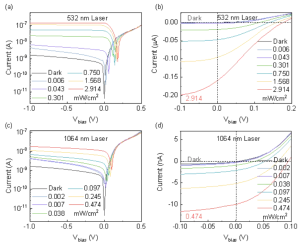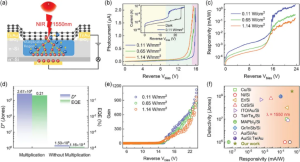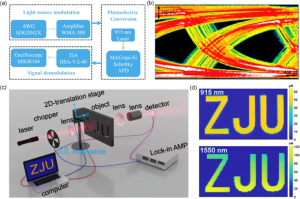Application of Lock-in Amplifier SE1022 in the Research of New Photoelectric Detector
Keywords: multilayer nanofilm graphene (nMAG), epitaxial silicon (epi-Si) vertical heterostructure photodetector, spectral dependence, lock-in amplifier
Note: This article uses the Saluki SE1022 lock-in amplifier to measure
【Overview】
In July 2024, Professor Xu Yang’s team from the School of Integrated Circuits at Zhejiang University published an article titled “Multilayer Graphene/Epitaxial Silicon Near-Infrared Self-Quenched Avalanche Photodetectors” in Advanced Optical Materials. Professor Xu Yang’s team studied a new type of multilayer graphene nanofilm (nMAG) and epitaxial silicon (epi-Si) vertical heterostructure photodetector (hereinafter referred to as nMAG/epi-Si detector). The detector exhibited high responsivity (2.51 mA·W−1) and detectivity (2.67×109 Jones) at 1550 nm, with a low avalanche initiation voltage and self-quenching ability during avalanche multiplication, and can achieve real-time data transmission rates of up to 38 Mbps in near-infrared optical communication data links. In recent years, two-dimensional materials have received widespread attention in the field of optoelectronic devices due to their excellent optoelectronic properties. However, the low light absorption coefficient of these materials limits the application of their detectors. To overcome this problem, researchers proposed to use two-dimensional materials to construct avalanche photo detectors (APDs) to achieve high gain through impact ionization. However, two-dimensional materials introduce large noise while multiplying photogenerated carriers, which affects the detection of weak light signals. In addition, two-dimensional APDs usually require high bias voltages to produce impact ionization, resulting in high power consumption. Based on the research on heterogeneous integration of two-dimensional materials and silicon, Xu Yang’s research group at the School of Integrated Circuits of Zhejiang University has fabricated a vertical heterostructure photodetector (nMAG/epi-Si detector) with low defect density and spectral dependence by heterogeneously integrating multilayer graphene with epitaxial silicon. Multilayer graphene serves as the main light absorption layer to broaden the detection band of silicon-based photodetectors; lightly doped epitaxial silicon serves as the photogenerated electron multiplication region, effectively suppressing the generation and multiplication of hot carriers; heavily doped substrate silicon can form an ohmic contact between the silicon semiconductor and the metal electrode, improving the current transmission efficiency, thereby reducing overall power consumption and improving energy efficiency.
【Measurement methods and some experimental results】
The research team transferred highly crystalline nMAG as an absorption layer onto lightly doped epitaxial silicon (epi-Si) to form a vertical heterostructure and prepared the nMAG/epi-Si detector (Figure 1a).
To evaluate the performance of the nMAG/epi-Si detector, the research team studied the changes in four indicators, namely, spectral response characteristics, external quantum efficiency (EQE), specific detectivity (D*), and noise equivalent power (NEP). By changing the wavelength of monochromatic light and measuring the short-circuit current of the detector at each wavelength, the research team was able to obtain a spectral response curve reflecting the spectral response characteristics. Figure 1(b) shows the spectral dependence of the nMAG/epi-Si detector. The spectral dependence was measured by a response measurement system equipped with a monochromator, a phase-locked amplifier ( Saluki SE1022), and a 150W xenon lamp. The nMAG/epi-Si detector exhibits a spectrally dependent photoresponse in the range of 300-1100nm, with a peak response of 0.38 A/W−1. The wavelength dependence of the responsivity indicates that the generated photocurrent comes from epitaxial silicon. In addition, the external quantum efficiency (EQE) of the nMAG/epi-Si detector in the visible light region is as high as 60%, but decreases as the excitation wavelength increases in the near-infrared region. Figure 1(c) shows the D* and NEP spectra of the nMAG/epi-Si detector in the wavelength range of 300-1100 nm. The results show that the D* and NEP can reach 6.63×1012 Jones and 5.80×10−13W/Hz-1/2,respectively.

Figure 1. (a) Schematic diagram of nMAG/epi-Si photodetector, (bc) spectral dependence of nMAG/epi-Si photodetector
Figure 2 shows the test results under illumination in the visible-near infrared band from 532nm to 1064nm. Under reverse bias, as the power density increases, the photocurrent increases, while the rectification ratio decreases. This is because under reverse bias, photogenerated carriers significantly change the concentration of minority carriers, resulting in the generation of photosensitive current.

Figure 2. Optoelectronic properties of nMAG/epi-Si detector: IV curve performance of nMAG/epi-Si detector at different power densities at (a) 532nm and (c) 1064nm, and at 532nm (b) and 1064nm (d), photovoltaic characteristics of nMAG/epi-Si detector at different power densities
The nMAG/epi-Si detector also exhibits self-quenching and high gain characteristics in avalanche mode and can operate at a wavelength of 1550 nm. When the bias voltage is increased, the nMAG layer acts as an absorption layer for the near-infrared long-wave spectrum in the nMAG/epi-Si device, as shown in Figure 3(a). On the other hand, the lightly doped epi-Si layer acts as a multiplication layer, and by controlling the applied bias, the electric field in the nMAG layer can be adjusted, where light is absorbed and photocarriers are generated. The photogenerated electrons gain large kinetic energy under the large internal electric field in the relatively wide depletion region, and can achieve avalanche multiplication by impact ionization with valence electrons in the lattice, thereby generating exponential growth of free electrons, resulting in a rapid increase in photocurrent. At a wavelength of 1550 nm, the nMAG/epi-Si detector exhibits a high responsivity of 2.51 mA/W−1 and a detectivity of 2.67×109 Jones, which is higher than that of the photodiode without avalanche (Figure 4d).
Figure 3. Working mechanism and avalanche multiplication characteristics of nMAG/epi-Si APD
The nMAG/epi-Si detector was integrated into an optical communication system as an optical signal receiver to measure the eye diagram, further demonstrating its feasibility in practical optical applications, as shown in Figure 4. The nMAG/epi-Si APD exhibits low noise current, and its fast response capability enables it to achieve a maximum real-time data transmission rate of 38 Mbps when used in near-infrared communication data links. In addition, the photodetector can also be used for near-infrared dual-color detection at room temperature, and has been successfully experimented.

Figure 4. Performance characterization of near-infrared optical communication
【Summarize】
The research team fabricated a nMAG/epi-Si detector with low defect density and spectral dependence, which has high responsivity and detectivity at a wavelength of 1550 nanometers, suitable for near-infrared optical communications and high-resolution imaging. It has high gain and self-quenching characteristics under low reverse bias, which reduces noise and improves signal stability. In addition, the low noise and fast response of the detector enable it to achieve a data transmission rate of 38 Mbps. These characteristics indicate that nMAG/epi-Si heterostructures have great potential in the fields of infrared detection and optical communications.
【References】
✽ Yang Xu, et al. Multilayer Graphene/Epitaxial Silicon Near-Infrared Self-Quenched Avalanche Photodetectors. Adv. Optical Mater. 2024, 12, 2400335.



